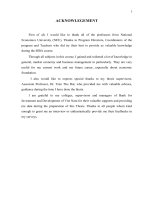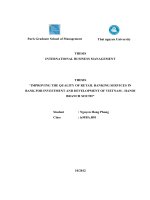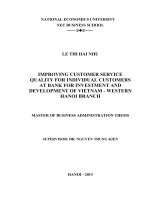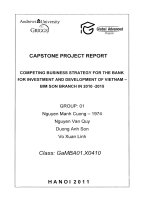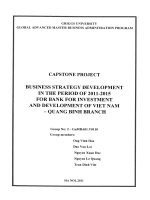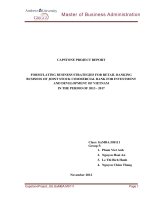Building business strategy at bank for investment and development of vietnam – tu liem branch in the phase of 2017 2021
Bạn đang xem bản rút gọn của tài liệu. Xem và tải ngay bản đầy đủ của tài liệu tại đây (1.33 MB, 86 trang )
ĐẠI HỌC QUỐC GIA HÀ NỘI
KHOA QUẢN TRỊ VÀ KINH DOANH
---------------------
ĐỖ ĐẠI DƯƠNG
BUILDING BUSINESS STRATEGY AT BANK FOR INVESTMENT
AND DEVELOPMENT OF VIETNAM – TU LIEM BRANCH
IN THE PHASE OF 2017-2021
XÂY DỰNG CHIẾN LƯỢC KINH DOANH TẠI NGÂN HÀNG
TMCP ĐẦU TƯ VÀ PHÁT TRIỂN VIỆT NAM – CHI NHÁNH
TỪ LIÊM TRONG GIAI ĐOẠN 2017 – 2021
LUẬN VĂN THẠC SĨ QUẢN TRỊ KINH DOANH
HÀ NỘI - 2018
ĐẠI HỌC QUỐC GIA HÀ NỘI
KHOA QUẢN TRỊ VÀ KINH DOANH
---------------------
ĐỖ ĐẠI DƯƠNG
BUILDING BUSINESS STRATEGY AT BANK FOR INVESTMENT
AND DEVELOPMENT OF VIETNAM – TU LIEM BRANCH
IN THE PHASE OF 2017-2021
XÂY DỰNG CHIẾN LƯỢC KINH DOANH TẠI NGÂN HÀNG
TMCP ĐẦU TƯ VÀ PHÁT TRIỂN VIỆT NAM – CHI NHÁNH
TỪ LIÊM TRONG GIAI ĐOẠN 2017 – 2021
Chuyên ngành: Quản trị kinh doanh
Mã số: 60 34 01 02
LUẬN VĂN THẠC SĨ QUẢN TRỊ KINH DOANH
NGƯỜI HƯỚNG DẪN KHOA HỌC: PGS.TS. NGUYỄN NGỌC THẮNG
Hà Nội - 2018
DECLARATION
The author confirms that the research outcome in the thesis is the result of
author’s independent work during study and research period and it is not yet
published in other’s research and article.
The other’s research result and documentation (extraction, table, figure,
formula, and other document) used in the thesis are cited properly and the
permission (if required) is given.
The author is responsible in front of the Thesis Assessment Committee,
Hanoi School of Business, and the laws for above-mentioned declaration.
Hanoi, date of …… / …… /……..
Do Dai Duong
ACKNOWLEDGEMENT
I hereby certify that I am the sole author of this thesis and no part of this
thesis has been published or submitted for publication. I certify that, my thesis does
not violate anyone’s copyright. Additionally, all ideas, quotations, or material from
the work of other people included in my thesis, published or otherwise, are fully
acknowledged with the standard of references.
I declare that this is a true copy of my thesis. The content of this thesis has
been approved by the committee of Vietnam National University, Hanoi – Hanoi
School of Business (HSB). This thesis has not been submitted for a higher degree to
any other University or Institution.
In order to finish this project successfully, I have received many helps,
supports and guidance from many people who I would like to thank sincerely.
First of all, I would like to thank all the professors of MBA program,
especially PSD, Dr. Nguyen Ngoc Thang – my suporvisor. Then I would like to
thank deeply the respondents and interviewees who allowed me to gather enough
data for this research. Finally, I would like to express my thanks to my family, my
colleges and my fellow friends who created convenient conditions and give me
encouragement and understanding for me to complete this degree.
I sincerely thank you!
Hanoi, date of …… / …… /……..
Do Dai Duong
TABLE OF CONTENTS
LIST OF ACRONYMS............................................................................................... i
LIST OF FIGURE, TABLES ..................................................................................... ii
HEADING ...................................................................................................................1
CHAPTER
1:
RATIONALES
ON
BUSINESS
STRATEGY
OF
THE
ENTERPRISES ...........................................................................................................4
1.1 The concepts of business strategy of the enterprises ............................................4
1.2 Characteristics of Business Strategy .....................................................................5
1.3 Requirements of business strategy for enterprises ................................................6
1.4 Purpose, objective necessity of building business strategy ..................................6
1.5 Process of business strategy development ............................................................7
1.5.1 Targeting ........................................................................................................7
1.5.2 Analyzing the basics of business strategy development: ...............................8
1.6 Tool to provide information for strategy development: ......................................15
1.6.1 Internal Factor Matrix (IFE): .......................................................................15
1.6.2 External Factor Matrix (EFE): .....................................................................15
1.6.3 Competitive Image Matrix: ..........................................................................16
1.7 Strategy development and selection: ...................................................................16
1.7.1 Matrix strengths - weaknesses, opportunities - risk (SWOT): .....................16
1.7.2 Strategic planning matrices can be selected .................................................17
CONCLUSION CHAPTER 1 ...................................................................................20
CHAPTER 2: CASE ANALYSIS OF JOINT STOCK COMMERCIAL BANK
FOR INVESTMENT AND DEVELOPMENT OF VIET NAM
– TU LIEM
BRANCH ..................................................................................................................21
2.1. Overview of the Joint Stock Commercial Bank for Investment and
Development of Viet Nam ........................................................................................21
2.2. About Joint Stock Commercial Bank for Investment and Development of Viet
Nam - Tu Liem Branch: ............................................................................................21
2.2.1 Formation and development process: ..........................................................21
2.2.2 Business activities of Tu Liem Branch: .......................................................22
2.2.3 Products and services: ..................................................................................24
2.2.4 Analysis of business activities of BIDV Tu Liem in 2016: .........................24
2.3. Analysis of external factors affecting the operation of BIDV Tu Liem: ...........27
2.3.1. Macroeconomic Analysis: ...........................................................................27
2.3.2 Micro-environment analysis (sectoral environment): ..................................33
2.3.3 Assessment of opportunities and challenges:...............................................44
2.3.4 Matrix of external factors .............................................................................45
2.4 Internal factor analysis of BIDV Tu Liem: .........................................................47
2.4.1 Human resources factor................................................................................47
2.4.2 Accounting and financial factors: ................................................................48
2.4.3 Research, Development and Marketing: ......................................................49
2.4.4 Information technology: ...............................................................................49
2.4.5 Assessment of strengths and weaknesses: ...................................................49
2.4.6 Matrix of internal factors: ............................................................................50
CONCLUSION CHAPTER 2 ...................................................................................52
CHAPTER 3: BUILDING THE BUSINESS STRATEGY OF JOINT STOCK
BANK FOR INVESTMENT AND DEVELOPMENTOF VIETNAM – TU LIEM
BRANCH IN THE PHASE OF 2017-2021 ..............................................................53
3.1 Business objective of BIDV Tu Liem period 2017 - 2021: ................................53
3.1.1. Strategic direction of BIDV in 2016-2020 ..................................................53
3.1.2 The objectives of BIDV Tu Liem in the coming time: ................................55
3.2 Strategic Analysis and Selection: ........................................................................56
3.2.1 Use the SWOT matrix to select business strategies: ....................................56
3.2.2 Analyze strengths, weaknesses, opportunities and challenges of BIDV Tu
Liem through the SWOT model ............................................................................57
3.2.3 Business Strategy Selection - QSPM matrix: ..............................................59
3.3 Specific strategies: ..............................................................................................60
3.3.1. Firstly, the strategy of developing products and services: ..........................61
* Overall objective: ...............................................................................................61
3.3.2 Second, capital development strategy: .........................................................62
3.3.3 Third, credit growth strategy: .......................................................................63
3.3.4 Fourth, training strategy and human resource development: .......................64
3.4 Some solutions to implement the business strategy of BIDV Tu Liem in period
2017 - 2021: ..............................................................................................................64
3.4.1 Capital operation ..........................................................................................64
3.4.2 Credit activities: ...........................................................................................65
3.4.3 Service activities: .........................................................................................66
3.4.4 Technology development: ............................................................................67
CONCLUSION CHAPTER 3 ...................................................................................68
CONCLUSIONS AND RECOMMENDATIONS ...................................................69
2.2. For the State Bank of Vietnam ...........................................................................72
REFERENCES ..........................................................................................................75
LIST OF ACRONYMS
NHNN
State Bank of Commerce
NHTM
Commercial banks
NHTMCP
Joint Stock Commercial bank
NHTMQD
Joint stock commercial banks of state-owned
BIDV
Bank for Investment and Development of Vietnam
BHXH
Social insurance
BIDV Tu Liem
Joint Stock Commercial Bank for Investment and Development
Vietcombank
of Vietnam - Tu Liem Branch
Vietinbank
Vietnam Joint Stock Commercial Bank for Industry and Trade
Agribank
Bank for Agriculture and Rural Development
SACOMBANK
Saigon Thuong Tin Commercial Joint Stock Bank
ATM
Automatic payment machine
BSMS
Information via mobile phone
EFE
Matrix evaluates external factors
IFE
Matrix evaluates internal factors
SWOT
Matrix Strengths-Weaknesses, Opportunities-Risk
SPACE
Matrix Strategic Positions and Assessment Activities
BCG
Matrix Teams Consulted Boston
IE
Matrix of internal-external factors
i
LIST OF FIGURE
Figure 1.1. PEST model ..............................................................................................8
Figure 1.2. The force model of M.Porter ..................................................................10
Figure 1.3. Model of choice of factors affecting business performance ...................13
Figure 1.4. Schematic diagram of SWOT .................................................................17
Figure 1.5. BCG matrix .............................................................................................18
Figure 2.1. Organizational model of BIDV Tu Liem ...............................................22
ii
LIST OFTABLES
Table 2.1. Update of business results of BIDV Tu Liem 30/06/2017 ......................22
Table 2.2. Evaluation of business results of BIDV Tu Liem 31/12/2016.................24
Table 2.3: Population pyramid chart of Vietnam in 2016.........................................31
Table 2.4. Credit outstanding, capital mobilized by banks 2016 ..............................35
Table 2.5. Comparison of NPL ratios, risk management of banks ...........................36
Table 2.6. Profit before tax and net service income of banks ...................................36
Table 2.7. Correlation of scale, performance and net interest income of banks .......37
Table 2.8. Financial indicators for banks in 2016 .....................................................37
Table 2.9. Network development of banks in the period 2011-2015........................37
Table 2.10. Relationship between GDP Growth and Credit .....................................38
Table 2.11. EFE matrix .............................................................................................46
Table 2.12. Human Resources of BIDV Tu Liem ....................................................47
Table 2.13. Matrix of elements within the IFE .........................................................50
Table 3.1. BIDV's objectives for 2016-2020 ............................................................54
Table 3.2. Targets of BIDV Tu Liem in 2017-2021 .................................................56
Table 3.3: SWOT matrix ...........................................................................................57
Table 3.4: QSPM matrix ...........................................................................................59
iii
HEADING
1. Reason for selecting the topic
The Fourth Industrial Revolution has been coming. This is unprecedented
revolution in human history, it will evolve very fast, is a combination of technology
in the fields of physics, digitization and biology, creating entirely new possibilities
and has a profound impact on the political, social and economic systems of the
world. More than ever, the only thing that businesses can know for sure is change.
Therefore, building and managing a strategy as a way to help businesses overcome
the turbulent in the market, reaching a future, by their own efforts and capabilities.
In Vietnam, businesses have been facing many difficulties arising from the
strong competition when opening the market. A business that wants to succeed
needs to be able to cope with every situation, be independent, make decisions and
take responsibility for all activities. Therefore, businesses need to grasp the trend is
changing, to exploit the strengths, limit the weaknesses, take advantage of
opportunity to overcome the challenge, thereby creating creative steps for
themselves. , in other words, build a proper business strategy.
Joint stock commercial Bank for Investment and Development of Viet Nam
(BIDV) is one of the four largest commercial banks in Vietnam, which is
undergoing a shift towards globalization and international economic integration.
With 60 years of development and development, BIDV has achieved many
successes in business activities. BIDV's reputation in the international market has
been affirmed as the leading financial institution in the financial institutions in
Vietnam.
Based on these perceptions and practices, who has worked for many years at
BIDV, is currently working at the Joint stock commercial Bank for Investment and
Development of Viet Nam – Tu Liem Branch- a member of BIDV. Along with the
knowledge gained from the MBA course of the Faculty of Business Administration
- Hanoi National University, I chose the topic "Building business strategy of the
Joint stock commercial Bank for Investment and Development of Viet Nam - Tu
Liem Branch in the phase of 2017 - 2021 "as his dissertation topic.
1
2. Research objects and scope of research
The subject of the dissertation is business strategy of Joint stock commercial
Bank for Investment and Development of Viet Nam - Tu Liem Branch.
The scope of the research is the business activity of BIDV Tu Liem,
compared with the overall business of BIDV and other competitors in the industry,
mainly commercial banks. Vietcombank, VietinBank, Bank for Agriculture and
Rural Development (Agribank) and other commercial joint stock banks in the area.
3. Objectives and objectives of the study:
3.1. Purpose of the thesis:
Developing a business strategy for BIDV Tu Liem between 2017 and 2021
and proposing solutions to implement this strategy to make BIDV Tu Liem one of
the strongest branches in the BIDV system and in the local area of Hanoi City.
3.2. Objectives of the study:
- Summarize basic theoretical issues related to business strategy planning,
strategy development, strategic development tools.
- Analyze the external factors, internal factors to find strengths, weaknesses,
opportunities - risk of BIDV Tu Liem in relation to the BIDV system in general.
- Define business objectives based on strengths, weaknesses, opportunities
and threats, develop business strategies and propose solutions to implement those
strategies on the basis of BIDV overall assessment in general and BIDV Tu Liem in
particular.
4. Research Methodology:
The lecture was completed on the basis of using the following research
methods: Methodology of theoretical study, combined with practical research at Tu
Liem BIDV; Secondary and primary data collection methods; Professional solution;
Methods of analysis, collation and synthesis. Combining the use of course methods:
Strategic Management, Human Resource Management, Marketing ...
Sources of information: The thesis uses secondary information from books,
magazines, wesite (asset.com, bidv.com.vn, vietinbank.com.vn ...), published
reports of Vietcombank, Vietinbank, Agribank ... at the State Bank.
2
5. The structure of the thesis:
The thesis consists of 3 chapters and introductory sections:
Chapter 1: Theories of business strategy of enterprises.
Chapter 2: Current Situation of Business Operations of Joint stock
commercial Bank for Investment and Development of Viet Nam - Tu Liem Branch.
Chapter 3: Business Strategy for Vietnam Development Investment Bank Tu Liem Branch 2017 - 2021.
The main content of each chapter is presented below.
3
CHAPTER 1
RATIONALES ON BUSINESS STRATEGY OF THE ENTERPRISES
1.1 The concepts of business strategy of the enterprises
The first strategic term used in the military field. Gradually, the strategy is
used in other areas of socio-economic life. The term "strategy" is a combination of
the word war, that is fighting, fighting and combing, that is, intrigue. Thus, in the
original, the strategy is to fight and more importantly to win.
Today, the term has been used in almost all fields: economics, politics and
culture. In the field of economics, at the macro level we may have concepts such as
"sectoral development strategy", "export-oriented industrialization strategy", microlevel, Combined with corporate management, the term "marketing strategy",
"production strategy", "business strategy" is formed. Due to the different
approaches to strategy that The concept of strategy is different, so far there is not a
common, consistent concept of this category. In the field of economics, the scope of
the strategy applied to enterprises may take into account some of the following
concepts:
"Strategy is the deciding factor of the organization's long-term goals" (Prof.
Alfred D. Chandler, 1962);
"Strategy is a red thread throughout the organization's operations" (Prof. H.
Igor Ansoff, 1965);
"Strategy is the art of creating competitive advantages" (M. Porter, 1980).
"The strategy is to outline the long-term, stable enough orbits around the
trajectory that can make the right decisions and the actions of the business" (Alain
Charles Martinet, 1983).
"A strategy is defined as a plan or business plan that guides or directs the
organization to the desired goal. This general operating plan provides the basis for
policies (orientation for decision approval) and operational procedures. "(Garry D.
Smith, Danny R. Arnold, Bopby G. Bizrell. "Business Strategy and Strategy").
In general, these concepts of strategic terminology are inclusive and reflect:
4
+ The objectives of the strategy;
+ Time of implementation;
+ Strategic decision making;
+ Competitive environment factor;
+ Advantages and disadvantages in general and in each activity in particular.
So, we see the strategy of the business is a "product" that combines what the
environment has? What business can? And what businesses want?
Together: In business, a strategy is to be understood as a design art, a means
of achieving long-term goals and a relationship with a changing and competitive
environment. . A good business strategy is a strategy in which a company can gain a
competitive advantage over competitors at an acceptable cost. To better understand
the business strategy category, we need to consider its characteristics so that we can
distinguish it from related concepts and categories.
1.2 Characteristics of Business Strategy
Business strategy often defines the basic objectives and business directions
of each enterprise in each period and is fully understood in all aspects of production
and business activities to ensure Business development is continuous and
sustainable (more than 1 year).
Business strategy ensures maximum mobilization and combines the
exploitation and use of resources of enterprises in the present and future, bringing
into play the advantages and grasp opportunities to win the market. business.
Business strategies must be reflected throughout a continuous process from
formulation, implementation, inspection, evaluation and strategic revision.
Business strategy is usually built for a relatively long period (3 years to 5
years), tendency to shorten down depending on the characteristics of each sector.
From the above characteristics, it is easy to distinguish the strategic category
from related concepts and categories. The concept closest to the strategy is "plan",
in fact many people mistakenly confuse the two concepts together. The striking
feature of the strategy is the direction and identification of major solutions and
policies to the main objectives, while the alignment plans are mainstream, all goals
5
are quantified. This is a system of indicators reflecting the comprehensive
production and business activities of enterprises.
1.3 Requirements of business strategy for enterprises
One key feature of this feature is that it clearly defines the business scope of
the business. This is an important step in business analytics, strategic direction,
resource allocation, and portfolio management. Two basic questions to ask are:
What business are we doing? And what business should we do?
This is a relatively complex issue as the market segmentation process has a
huge impact on the organizational structure of the business.
Business strategy creates a mutually supportive relationship with the
opportunities and challenges outside the enterprise, the strengths and weaknesses of
the business, and thus create the competitive edge of the business.
This feature highlights a key issue of the strategy that is to create a
sustainable long-term competitive advantage over the main business competitors in
the business sector in which the business engages. This is a modern approach that is
used to study the competitive position of the business.
1.4 Purpose, objective necessity of building business strategy
Building a business strategy is one of the most important activities of senior
managers. A non-strategic organization is like a rudderless ship. Without a proper
strategy implemented effectively, failures are almost certain. Building a business
strategy that brings practical benefits to the business is:
Help your business see its future in the future so that executives will consider
and decide when and how to reach the target.
Helps administrators stay motivated by environmental changes: Helps
administrators clearly see opportunities and threats in the current business
environment to analyze, evaluate and forecast conditions. business environment in
the future. This helps the company take advantage of opportunities, repel the risk to
win the competition, win.
Helping businesses maximize and exploit their resources. thus promoting the
maximum strength of the business to grow up; Allocate resources from one place to
another in a rational manner.
6
Helping businesses increase the alignment of employees and administrators
in the implementation of corporate goals, thereby creating the internal strength of
the business. Help businesses increase sales, increase employee productivity and
increase governance, avoid risks, increase prevention and prevent problems for
businesses.
1.5 Process of business strategy development
1.5.1 Targeting
Strategic goals are the desired goals of the business. It is to specify the
purpose of the business in terms of direction, scale, structure and implementation
process over time. In the market economy, businesses generally pursue three main
purposes: existence, development and diversification. The strategic target system
also expresses the desire to achieve certain results during the strategic period. There
are usually two types of objectives: short-term and long-term.
Long-term goal: is the final desirable result that the business wants to achieve
over a period of more than a year, with the specific content: profitability,
productivity, competitive position, employment, community relations, technology
position, social responsibility.
Short-term goals: These are the specific results an enterprise expects to
achieve in a cycle, quantified.
When defining the target system, the following requirements must be met:
Specificity: Objectives must be clearly defined in each period, must have
common goals and objectives.
Linking: Goals must ensure cohesion, mutual reciprocity, or otherwise, in
achieving this goal, without interfering with the achievement of other objectives.
Priority: Define the priority of each objective and the hierarchy of each goal.
Flexibility: The objectives set out need to be flexible enough to be adapted to
the changing business environment.
Feasibility: The goal must balance the difficulty and the reality.
Quantitative: Targets must be defined in a measurable or quantifiable form.
7
Rationality: The goal must be accepted and fully understood by the
implementers.
1.5.2 Analyzing the basics of business strategy development:
1.5.2.1. Macroeconomic Analysis:
For macro-economic analysis, the PEST theory includes assessments of
political (P), economic (E), social (S), and (T) and threatening to businesses
operating in that business environment.
Factors of political law are the foundation for shaping other elements of the
business environment, which means the political platform, and the legal
environment that has that business environment. These factors include the political
system, the legal system. Lenin said: "There is no political issue, no pursuit of
economic gain and no economic problem for political ends." Therefore, if the
political system is stable, the political path is clearly open, creating opportunities
for businesses and vice versa. Apart from analyzing the legal elements of the host
country, enterprises must also study the legal environment of the countries where
the investment-oriented enterprises come.
Figure 1.1. PEST model
(Economics)
(Political)
- Political stability
- Labor Law
- Policy of tax
- Legal System
- Regulatory
environment
(Social)
- Change of GDP
-Population, demographic
- The rate of economic
growth
- Distribution of national
income
- Interest rates, inflation
- Lifestyle
- Unemployment
- Economic cycle
(Technological)
- Discover new technology
- Speed of technology transfer
- Government spending on R & D
- Market of technology products
8
etnamese people, culture
- Customs and habits
+ The economic factors play the most important role in these factors affecting
the business activities of enterprises. It includes factors such as economic growth
rate, exchange rate, inflation rate, interest rate policy, economic policy ... If the rate
of growth of the economy is high, the exchange rate increases , stable inflation rate,
appropriate interest rate policy, economic policy to create a level playing field for
businesses, it is an opportunity for businesses. In contrast, these factors will create
challenges for businesses operating in that economy.
+ Cultural and socio-cultural factors have a slow impact on the business
environment but have a strong impact by influencing market demand such as
changing customs and habits.
+ In the real estate business, population and demographic characteristics play
an especially important role in creating markets for the industry. The size of
population, population density, consumption habits, habits of people and
demographic characteristics by age, ethnicity, distribution have a great impact on
the sector.
+ Technological factors play an increasingly important role in determining the
business environment of enterprises in two directions. Technology technology
directly affects and determines the two basic factors that make the products
competitive in the market, quality and price. New technology also affects the state
of the art facilities for businesses through the transfer of technology and the
process of collecting, processing storage and transmission of economic
information. Assembly.
1.5.2.1. Sectoral Environmental Analysis:
An industry is a group of companies that provide products or services that can
be closely intertwined. In competition, companies in the industry are influential.
Generally, each sector consists of a mixture and variety of competitive strategies
that companies pursue to try to achieve a higher than average income.
Industry analysis and competition to shed light on key issues:
- The economic characteristics of the sector.
Competitive forces are active in the industry, the nature and power of each force
9
- Motivations for change in the industry and their impact
- Companies with the strongest and weakest position.
- Who would be the one who made the next move in the industry?
- Key factors for success in competition
- The attractiveness of the sector in terms of profitability above average.
Managers can not form a long-term orientation, or a strategic decision, if they
do not have a keen understanding of the company's strategic situation, the nature
and the competitive conditions that it does. to face, how to create a fit between
resources and capabilities with those conditions.
Potential
opponents
Pressure of the
supplier
Competitors in the
industry
Pressure of the
buyer
Alter
native
servic
e
produ
cts
Figure 1.2. The force model of M.Porter
The author approaches the competitive model of M. Porter, which includes 5
competitive forces that help strategists in the analysis of the sectoral environment.
The task of the strategists is to analyze and judge Competitive forces in the industry
to identify opportunities and threats to their businesses.
● Competitors:
10
The first of the five forces of the M.Porter model is the size of competition
among the existing firms of a manufacturing sector. If the weaker the competition,
enterprises have the opportunity to increase sales prices and make more profits. On
the contrary, when competitors are strong, price competition is significant, and price
competition leads to vulnerability. Competitors are companies that are working in
the same industry as the business, and they are looking to increase sales, increase
profits through policies and measures that create disadvantages for businesses.
Because of the limited market size, businesses compete for market share by
reducing prices, advertising, promoting, persuading customers, improving quality of
products and services, creating prices. for customers.
● Customers:
Buyers can be seen as a competitive threat when forcing a business down or
demanding higher quality and better service. Conversely, when weak buyers will
give the business the opportunity to increase prices earn more profits. Buyers
include: final consumers, distributors (wholesalers, retailers) and industrial buyers.
Customer pressure is usually expressed in the following cases:
When buyers are small and large, suppliers are small and medium in the
supply chain.
Customers buy a large volume.
The supply chain depends on the customer with a large percentage of the
total order.
Customers can use vertical link strategy.
Customers have the information about the market as the demand, prices ... of
the suppliers, the bargaining pressure of them is greater.
● Supplier:
The third force in competitive forces is the bargaining power of the supplier.
Suppliers can be considered as a threatening pressure when they are able to increase
their selling prices or reduce the quality of the products or services they provide.
This reduces the profitability of the business. Suppliers' pressure is usually
expressed in the following situations: When the supplier is an exclusive supplier,
11
the situation does not have a substitute product; The enterprise is not the preferred
customer of the supplier; The type of input provided by the supplier is important to
the business; A strategic alliance or competition in the supply or supply chain is a
solution to reduce the pressure of this environmental factor.
● Potential competitors:
Potential competitors are current businesses that are not competing in the
same industry; But they are competitive if they choose and decide to join the
industry. This is a threat to existing businesses. Existing businesses try to prevent
potential competitors from entering the industry because more and more businesses
are in the industry, the competition is fiercer, the market and profits are shared. the
position of the business will be changed.
● Replacement:
The last force in M.Porter's model is the threat of alternative products.
Replacement products are other products that can satisfy the same needs of the
consumer. Its basic characteristics often have advantages over the product being
replaced in its own distinctive features. The appearance of alternatives is varied and
complex, creating a very competitive price risk for the old product, reducing the
profitability of the business. To limit the impact of this risk, businesses must also
invest properly in R & D.
1.5.2.2. Analysis of internal environment of enterprises:
A thorough analysis of the internal factors of enterprises to clearly identify
the advantages and disadvantages of enterprises. When doing this, the bottom line is
how to identify areas of concern, which issues need to be investigated and what
criteria to evaluate it well or not so well that it can receive In this segment of the
strong business, in the other business sector weak. The author approaches
quantitative and qualitative methods based on the following evaluation models.
From there, measures are taken to reduce the disadvantages and promote the
advantages to achieve the maximum advantage. Thus, the manager will be better
aware of internal circumstances by analyzing the following key factors:
• Elements of human resources:
12
Human resources play a very important role in the success of the business.
As humans gather data, plan the target, select and test the strategies of the business,
and to achieve good results, there is no shortage of effective people. When
analyzing the human resources of the enterprise, attention should be paid to: the
professional qualifications, experience, skills and ethics of the staff; the personnel
policies of the enterprise; the ability to balance the level of labor use at the
maximum and minimum levels; capacity, level of interest and level of top
management ...
Figure 1.3. Model of choice of factors affecting business performance
Consider the actual
evaluation of
personnel work
Considering the actual
assessment of Financing
- Accoungting
Considering
the
actual assessment of
the organization and
operation
of
production
Review the actual
marketing
Reviewing the actual
R & D, receiving
information
processing
Select the
most
influential
factors to
the results
of
productio
n and
business
activities
Carry
out the
calculati
on and
importan
ce of
each
factor to
the
producti
on and
business
activities
of the
company
Mode
ling
and
evalu
ating
points
Prelimin
ary
analysis
Considering actual
evaluation of other
tasks
• Development factors:
Research and development efforts can help businesses play a leading role in
the industry or vice versa, leaving companies lagging behind industry leaders.
Therefore, enterprises must constantly change in terms of technological innovation
related to technology, products and raw materials.
• Factors of production:
13
Manufacturing is one of the major activities of the company associated with
the creation of products, strongly influencing the success of the business. The
production of relatively high quality products with relatively low prices will bring
many benefits for businesses. Particular attention should be paid to the analysis of
the factors of production: price and level of supply of raw materials, inventory
turnover, layout of production facilities, efficiency and cost of production. cost, and
technological capabilities over the industry and its competitors.
• Financial and accounting factors:
The functions of the finance department include the analysis, planning, and
monitoring of the financial performance and financial performance of the firm,
which has a profound impact throughout the enterprise. When analyzing financial
and accounting factors, managers should focus on the following contents:
Capability to mobilize short-term and long-term capital; Total capital of enterprises;
Flexibility of capital structure; ability to make use of financial strategies; The ability
to control cost reduction; The accounting system is effective and serves for cost
planning, financial planning and profitability.
• Marketing Factor:
The functions of the marketing department include the analysis, planning,
implementation and monitoring of the implementation of the proposed programs,
the maintenance of relationships and exchanges with clients on the principle of
mutual benefit. profit. Thus, in general, the task of marketing management is to
adjust the level, time and nature of demand between customers and businesses to
achieve the goal.
• Information Technology Factor:
When evaluating information systems, we will consider aspects such as the
level of application of information systems in management and production
activities; update, volume, abundance of information; the accuracy of information
sources and the security of the system. From here we will get the assessment,
integrated in the model of internal environment assessment of enterprises.
14
1.6 Tool to provide information for strategy development:
1.6.1 Internal Factor Matrix (IFE):
This matrix summarizes and evaluates the important strengths and
weaknesses of the functional business divisions, and it also provides the basis for
identifying and evaluating the relationship between these divisions. The IFE matrix
is developed in 5 steps:
Step 1: List the key success factors as identified during the assessment of
internal factors.
Step 2: Sort the importance from 0.0 (unimportant) to 1.0 (very important)
for each factor.
Step 3: Classify from 1 to 4 for each factor, where: 1 represents the greatest
weakness, 2 represents the smallest weakness, 3 represents the weakest, and 4
represents the strongest. biggest.
Step 4: Multiply the importance of each factor to its classification (by step 2
x step 3) to determine the score of importance.
Step 5: Add the total score on the importance for each factor to determine the
score of importance.
Regardless of how many factors the IFE matrix has, the maximum number of
points a business can receive is 4.0, the lowest is 1.0 and the average is 2.5. A score
greater than 2.5 indicates that the firm is strong in points and vice versa if less than 2.5.
1.6.2 External Factor Matrix (EFE):
The External Factor Matrix (EFE) helps us summarize and quantify the effects of
environments on the business. The development of an EFE matrix consists of 5 steps:
Step 1: List the factors that are critical to the success of the business as
identified in the macroeconomic assessment process.
Step 2: Sort the importance from 0.0 (unimportant) to 1.0 (very important) for
each factor.
Step 3: Categorize 1 to 4 for each success factor to show how the current
strategies of the business respond to these factors. In which: 4 is good response, 3 is
above average, 2 is average, 1 is weak.
15
